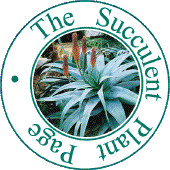 
Glossary of Botanical TermsTo locate the word in which you are interested:
|
A B C D E F G H I J K L M N O P Q R S T U V W X Y Z
Click on a letter to see definitions of all words beginning with that letter.S
Sagittate - shaped like an arrow head with two lobes pointing backwards.
Saline - salty.
Samara - a winged fruit containing a single seed. (Latin: samara = elm seed).
Saprophyte - an organism deriving its nourishment from decaying or non-living organic material.
Saprophytic - of a free-living organism obtaining all nutrients from non-living organic sources.
Sarcody - a hyperplastic symptom in which swellings occur above and below portions of organs that are tightly encircled, as a stem might be 'choked' by a tight tie or binding or by a twining vine.
Satellite DNA - short sequences in eucaryotic DNA that are present in large numbers of repetitive copies, differ in base composition and therefore density from most of the DNA and are generally not transcribed. Often associated with the centromere.
Satellite virus - of a small virus associated with tobacco necrosis virus (TNV), which is dependent upon the TNV genome for its own replication. Of a defective virus associated functionally with another virus which it depends on for replication.
Savanna - a plant community dominated by grasses with occasional scattered trees.
Scab - a hyperplastic symptom of disease characterised by rough, crusty lesions formed by excessive cork production. A disease in which such lesions form.
Scabrous - of a leaf, roughened by tubercles, hairs or other structures on its surface.
Scale - a small leaf like structure. A narrow, triangular or spine-like lower perianth segment often found on the ovary or flower tube surface. Also see scale insect.
Scale insect - a small flat insect pest, with a waxy dorsal shield, that adheres to the plant epidermis and feeds from the plant sap.
Scandent - climbing.
Scape - a long flower stalk arising directly from a root. Adj. scapose- borne on scapes.
Scarification - a mechanical abrasive seed treatment which helps to break down a hard or impervious seed coat as an aid to germination.
Scarious - having a dry membranous appearance.
Scion - the top part of a graft.
Sclerophyll - (Greek = hard-leaved) - a woody plant with small, leathery, evergreen leaves that retain water and typically found in hot, dry climates such as Australia.
Scorch - dry brown discolouration giving a 'burnt' appearance to leaf margins as a result of infection or exposure to unfavourable environmental conditions.
Scoria - crushed volcanic rock.
Scrotiform - shaped like a hollow pouch or sac.
Scrub - a plant community dominated by low shrubs.
Seed - a sexually-produced embryo, consisting of an axis (root and stem, or hypocotyl and epicotyl) and in Cactaceae two cotyledons, with its associated protective and nutritive structures capable of developing into a plant.
Seismonastic - a movement response to a shock stimulus. Of the movement of the stamens towards the pistil when touched.
Senesce - to age naturally.
Senescence - natural aging of a part.
Senescent - of an aging part.
Sepal - one of the separate perianth leaves of the calyx.
Sericeous - silky.
Serrated - bearing straight-sided teeth. Hence:
Serrate - with edges like a saw blade.
Sessile - stalkless, immobile e.g. of a flower with no stalk but attached directly to the stem.
Setaceous - bearing bristles.
Setose - terminating gradually in a fine sharp bristle.
Sexual - of reproduction through the merging of male and female gametes to form a zygote which develops into a new plant.
Shrub - a horticultural term for a low bushy plant with multiple stems normally branching from the base, rather than having a single stem branching higher up as in the case of a tree.
Simple - of a leaf with an undivided blade, although it may be lobed. Of a fruit developed from a single ovary.
Sinuate - wavy-edged.
Soft Water - contains relatively low concentrations of salts (usually calcium and magnesium) that interfere with the formation of a lather with soap. Soft water from a treatment plant may contain sodium ions conferring a salty taste and making it unsuitable for irrigation.
Sp. - abbreviation for species, used as the second part of a binomial name when the genus is known, but not the species.
Spadix - a spicate inflorescence with congested, often tiny, flowers and a stout, often fleshy or succulent axis, often more or less surrounded by a spathe. Characteristic morphology of the family Araceae.
Spathe - a large, often showy, solitary bract or pair of bracts ensheathing a spadix or other inflorescence on the same axis.
Spathulate - spoon-shaped.
Spatulate - long and thin, broadening towards the tip, like a spatula.
Specialist natural enemy - a predator which attacks only one (or a few) species. Specialist natural enemies are sometimes used as biological controls.
Speciation - a process of differentiation of a single species into one or more distinct species. This can occur through geographic isolation, where the species no longer interbreed and their characteristics slowly change under different environmental pressures.
Species - a population of individuals recognisable by morphological characteristics and unified genetic relationship, sometimes capable of subdivision into subspecies or varieties which are sufficiently closely related for interbreeding to produce offspring classified within the same species and with the same morphological characteristics.
Specific - pertaining to a species.
Sphagnum - any moss of the genus Sphagnum, sometimes used as a growing medium for e.g. epiphytes.
Spheroid - spherical with slightly flattened ends.
Spicule - a very small, fine spine or in Opuntioideae a glochid.
Spike - simple inflorescence, an elongated multiple cluster of sessile florets directly attached to an unbranched flowering stem. Hence: adj. spicate.
Spination - the characteristics and distribution of spines, which may in some cases be distinguishing features.
Spine - a sharp outgrowth from the epidermis which may be stout and woody or fine and hair-like. In Cactaceae always arising multiply from an areole and originating as a modified leaf. Spines are classified as central spines located centrally on the areole and radial spines around the margins of the areole. Spines protect the plant from some predators, albeit inefficiently. In some species, spines act as a drip tip where atmospheric moisture from dews, mists and rain precipitates on the spines and drips off the tip onto the soil near the base of the plant for uptake by the shallow root system.
Compare with thorns.
Splitter - coloquial - one who takes a narrow view of a genus, dividing up variant forms into individual species.
Spiral - corkscrew-shaped. Of leaves or other parts arranged around a stem or other structure.
Spore - a single, vegetative, reproductive cell formed by lower plants (cryptogams), that does not contain an embryo.
Sporopollenin - a polysaccharide biopolymer, made from cross-linked phenolics and hydrocarbons, forming a large proportion of the outer wall of pollen grains. Sporopollenin is highly resistant to acids, bases and decay processes so identifiable pollengrains persist in ancient deposits as a fossil record of plants flowering in that era.
Spreading - growing outwardly by means of new shoots or advancing outwards by means of rooting from reclining stems. In Cactaceae an array of radial spines projecting obliquely outwards around an areole, but not lying flat against the surface of the plant.
Spur - a usually slender hollow projection formed by the fused bases of the lower petals, often containing nectar, in some flowers or a short fruit-bearing stalk.
Stalk -
i. a slender or elongated fleshy structure that supports a plant or plant part such as a leaf or flower or a fungus.
ii. waste plant material consisting of stem, seed pod etc. separated from harvested seeds.
Stamen - pollen-bearing male sexual organ of a flower, consisting of anther and filament.
Staminate - of a male flower possessing stamens but not a pistil.
Staminode - a sterile stamen.
Starch - an insoluble high molecular weight (typically several million kDa) polysaccharide formed from beta-D-glucose units linked together with alpha-1,4' linkages (compare with cellulose). Amylose starches are long unbranched molecules whyle amylopectins are branched polysaccharides with alpha-1,6' linkages at the branch point. Starches can be broken down easily into glucose, as required, by amylase enzymes in the tissues and are the principal food storage substance of plants. Starch can be recognised by forming a characteristic blue colour with iodine.
Stellate - star-shaped.
Stem - the main axis of a plant which may carry other parts.
Sterile - incapable of engaging in the process of sexual reproduction.
Stigma - receptive surface or structure for pollen at apex of style or pistil. One style may bear multiple stigmas, in Cactaceae usually 3-20.
Stipe - a short supporting stalk.
Stipitate - having, supported or elevated on a stipe.
Stipulate - of a part furnished with stipules. Of a stem or leaf stalk (petiole) with a pair of growths resembling leaf stipules at the base.
Stipule - a small leafy growth, often found in pairs, at the base of a leaf or stalk.
Stolon - a prostrate basal branch above or below the ground which can root and produce new plants at its tip.
Stoma - (Pl. stomata) - a very small opening or pore through the plant's epidermis, through which respiration and transpiration occurs, surrounded by two guard cells. The stoma is usually capable of active opening and closing through changes in shape of the guard cells. Stomata are found on the plant body of Cactaceae and on any leaves.
Stone - the hard woody inner layer of the pericarp of fruits known as drupes ( e.g. cherries, peaches, plums ) within which is the seed.
Stratification - a process of exposing sown seeds to low, near freezing temperatures to imitate natural over-wintering as an aid to germination. During the process, chemical inhibitors of germination are broken down.
Strophiole - (syn. Caruncle - ) of a band or twisted band; a crestlike, corky excrescence about the hilum of certain seeds, derived from the funicle.
Strychnine - a bitter alkaloid poison found in the seeds of the asian tree Strychnos nux-vomica native to India, Sri Lanka and Australia. Strychnine has been used as a poison for several hundred years and causes characteristic convulsions.
Striate - a surface marked with longitudinal (lengthwise) lines, in some cases exhibiting slight ridges or furrows.
Style - structure, usually slender connecting ovary and stigma.
Sub - a prefix to a descriptor meaning "almost".
Subclass - a subdivision of a class.
Subgenus - a subdivision of a genus into morphologically recognisable groupings of species.
Subspecies - a subdivision of a species, recognisable by morphological characterisitics, but not isolated by genetic barriers from other members of the species. Sometimes designated as a variety.
Subulate - slender or tapering and flattened into a narrow elipse in cross-section, awl-shaped.
Succulent - juicy (Latin: succus = juice,sap), fleshy plants that store water in specially adapted thickened or swollen organs such as leaves, stems or roots.
Suckers - shoots or small plants arising from the base of a larger plant.
Sulco - of a plant or part with a groove or furrow (Latin: sulcus = furrow or groove).
Superior - above other parts, higher in rank or position.
Sustainable use - the careful exploitation of natural resources without destroying them.
Symbiosis - (Greek: = living together) - a balanced partnership in which two dissimilar organisms live together for their mutual benefit e.g. the algae and fungae jointly forming lichens. See also commensal and parasite.
Sympetalous - (gamopetalous),
of a flower with a corolla composed of partially or wholly fused petals forming a tube or funnel.
Synonym - an invalid name according to the International Code for Botanical Nomenclature.



